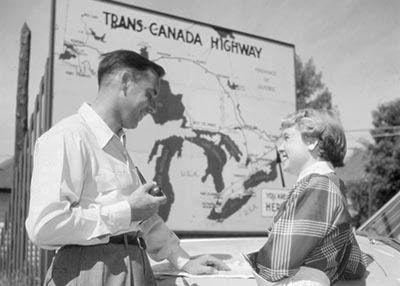By Staff Black Press
On September 3, 1962, Prime Minister John Diefenbaker officially opened the Trans-Canada Highway at a ceremony in Rogers Pass, British Columbia. However, the highway, which stretches 7,821 kilometres between St. John’s, Newfoundland, and Victoria, British Columbia, was in fact only completed to determined specifications in 1971.
Formal construction began in 1950 under the Trans-Canada Highway Act, which set up parameters for cost sharing between the federal and provincial governments to build the roadways. Some sections had already been constructed, such as Highway 17 in Ontario, while others were yet to be formed at all. The project was scheduled for completion sometime in 1956, but certain stretches proved more difficult to construct than anticipated. The two most challenging sections were the passage alongside Lake Superior between Sault Ste. Marie and Wawa in Ontario and the mountainous area through Revelstoke and Golden in British Columbia. In Ontario, the difficulty lay in the need to build 25 bridges and clear 98 kilometres of virgin forest. The task was at last completed in September of 1960. In British Columbia, work was delayed and plans were revised due to the site being under constant threat of an avalanche. Snow sheds and earth dams were constructed to ensure the safety of workers, and the Department of National Defence was enlisted to help guard future motorists against potential calamities—a job it still performs to this day. The stretch was opened to the public on June 30, 1962.
As all roadways do, the Trans-Canada Highway continues to evolve, with many provinces electing to add new stretches to the already established route. In many locations, twinning—the process of broadening the highway to add two full lanes on either side of a median—is also underway (or already compete in the case of Alberta, Saskatchewan and Manitoba).
In addition to the 7,821-kilometre main stretch, several alternative routes are considered official segments of the Trans-Canada Highway, bringing its total length to 12,800 kilometres of pavement. For example, in the Maritimes, one passage crosses Prince Edward Island while another avoids it, venturing exclusively through Nova Scotia. In Ontario, motorists can either follow the coast of Lake Superior or head north and cruise through the forested area of Kapuskasing. And west of Winnipeg, travellers can choose to stay on the original stretch and pass through Regina, Calgary and Banff, or take an alternate route further north, along the Yellowhead Highway, that traverses Saskatoon, Edmonton and Jasper.
No matter which route you take or how much time you spend on the highway, however, one thing you’ll never come across is its end: both St. John’s and Victoria claim the prestige of being mile zero of the world’s longest road.
